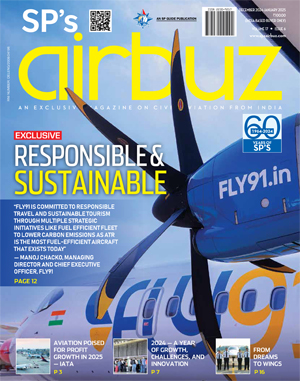Huge Leap in Engine Performance

The foundation of the LEAP engine is heavily rooted in advanced aerodynamics, environmental and materials technology development programmes.
The aviation community is seized with a major challenge – that of reducing fuel consumption, primarily due to rising fuel prices and environmental concerns. Aviation turbine fuel (ATF) remains a major cost component across the world. In 2012, US commercial air carriers burned 10.6 billion gallons of jet fuel costing $31.6 billion, while international carriers spent another $18.8 billion on 6.5 billion gallons of jet fuel. ATF prices are hovering above $100 per barrel. With ATF accounting for up to 40 per cent of the operating cost of airlines in India and elsewhere, there is no other option but to squeeze the most out of engines to reduce fuel burn.
Enhancing Fuel Eficiency
The aviation community is working at different levels to reduce fuel consumption and one constant effort has been to make engines highly fuel efficient. Engine makers are working overtime to develop engines that address the concerns of airliners. CFM International, a 50:50 joint company between Snecma (Safran) and GE, is developing CFM LEAP (Leading Edge Aviation Propulsion) engine which is expected to deliver 15 per cent improvement in fuel efficiency as compared to the CFM56-7BE.
By utilising an extensive suite of advanced engine technologies, the CFM LEAP engine is being designed to provide significant reduction in fuel burn, noise and NOx emissions compared to the current CFM engine models. The foundation of the LEAP engine is heavily rooted in advanced aerodynamics, environmental and materials technology development programmes. Along with superior technology, CFM reiterates its commitment to reliability and low maintenance costs.
Powering Airliners
At the time of the launch, there was no specific aircraft application. However, in 2009, COMAC chose the LEAP-1C engine as the sole Western power plant for the C919 in 2009. Airbus followed in 2010 when it selected the LEAP-1A engine as an option on the A320neo family and in 2011, Boeing selected the LEAP-1B as the sole power plant for its new 737 MAX.
Competition in this segment is increasing with CFM and Pratt & Whitney locked in a fierce battle to gain market share and also entry into service. The CFM engine powered A-320neo is scheduled to enter service in mid-2016, later that Pratt’s A-320neo slated for end 2015. Pratt & Whitney has over 4,500 PurePower engine orders and commitments including options, from more than 40 customers around the world, which helps it maintain its lead over Airbus A-320neo engine orders. CFM has stolen a march over Pratt, bagging over 5,400 LEAP engine orders.
Jean-Paul Ebanga, President and CEO of CFM International, said that in view of the demand, CFM will maintain the highest production rate in the industry. The company is on track to deliver approximately 1,500 CFM56 engines each year in both 2013 and 2014. Over the next few years, it will continue to ramp CFM56 production while simultaneously transitioning to the new LEAP engine family. There is a current backlog of more than 10,000 undelivered CFM56 and LEAP engines. By 2019, CFM anticipates a production rate of 1,700 engines per year. The company will continue to build both installed and spare CFM56-5B and CFM56-7B engines to meet demand as it moves to full LEAP production. Based on the size of the current CFM56 commercial fleet in services (18,000 engines), CFM expects to manufacture CFM56 spare parts at least until the year 2040.
CFM56 engines power the Airbus A318/A319/A320/A321, the A318 Elite and A319CJ, A320CJ, and A321CJ corporate jets and A340-200/-300 models and the Boeing NextGeneration 737-600/-700/-800/-900/-900ER and BBJ airplanes. LEAP engines power the Airbus A320neo, Boeing 737 MAX, and COMAC C-919 aircraft families.
Production if the LEAP Engine
Two engine families have contributed significantly to the design of the LEAP engine, the CFM56 and the GE90/GEnx series of engines. The GE90/GEnx contributed the high-efficiency core architecture to minimize fuel consumption, while the CFM56 legacy drove reliability and maintenance cost design practices. At entry into service in 2017, it is estimated that the GE90/GEnx architecture will have generated 80 million flight hours of revenue service, while the CFM56 family will have over 700 million flight hours of experience. The LEAP engine family offers proven, material advantages over any other engine, with 5,50,000 hours of proven experience with 99.98 per cent reliability, and 22,000 engines delivered on-time and on-specifications.
CFM International has completed testing of the first full LEAP engine with outstanding results. The LEAP-1A engine fired for the first time in September last. The engine, which was operating smoothly at full take-off thrust in a matter of hours, logged a total of 310 hours and more than 400 cycles during approximately five weeks of testing. “We couldn’t be happier with the results we achieved,” said Cédric Goubet, Executive Vice President of CFM International. “The engine ran beautifully and met all of our pre-test predictions. The more testing we do, the more confident we become in the capabilities this engine will bring to the marketplace.”
In 2014, a total of 15 LEAP engines (a combination of all three models) are scheduled to be on test. Among the tests planned for next year, CFM will complete early icing tests at GE facilities in Winnipeg, Canada, as well as early endurance testing. Both the LEAP-1A and -1C configurations are on schedule for flight tests in 2014, as well. “We still have a lot of testing ahead of us, and problems may turn up in future engines,” said Chaker Chahrour, Executive Vice President for CFM. “However, the point of these tests is to push the engine as hard as we can. We got a tonne of great data that has given us real insight into this engine, and we are right where we want to be.
“Our goal is to identify potential problems on our test stand and fix them long before we ever install these engines on our customers’ airplanes. That’s the reason we are also doing a few certification tests early. We have every confidence in our technology but, with the fastest ramp-up in aviation history ahead of us, we have to do everything we can to make sure we get it right the first time.”
The first engine test launched an extensive ground and flight test certification programme that will encompass 60 engine builds over the next three years and will accumulate approximately 40,000 cycles before entry into service. “In the past five years, we have completed thousands of hours of component testing leading up to this day,” said Chaker Chahrour. “Everything we have seen tells us the LEAP engine is going to deliver all we promised and much more. Now, we get to put it through its paces in the most comprehensive test programme we have ever undertaken. By the time this engine enters services, we will have simulated more than 15 years of airline service with 60 different engine builds.”
The CFM LEAP-1B will be the exclusive powerplant for the Boeing 737 MAX family of single-aisle aircraft (737 MAX-7, 737 MAX-8, 737 MAX-9). This engine has been optimised to provide the 737 MAX the best possible fuel efficiency while maintaining the reliability and maintenance cost legacy of the CFM56 family.
The engine, which shares common turbo machinery with the LEAP-1C, is installed at Site 3B at GE’s Peebles, Ohio, outdoor test facility, where it will be on test. The overall certification programme, which encompasses all three LEAP engine variants includes 28 ground and CFM flight test engines, along with a total of 32 flight test engines for Airbus, Boeing and COMAC. Over the next three years, these engines will accumulate approximately 40,000 cycles leading up to entry into service.





